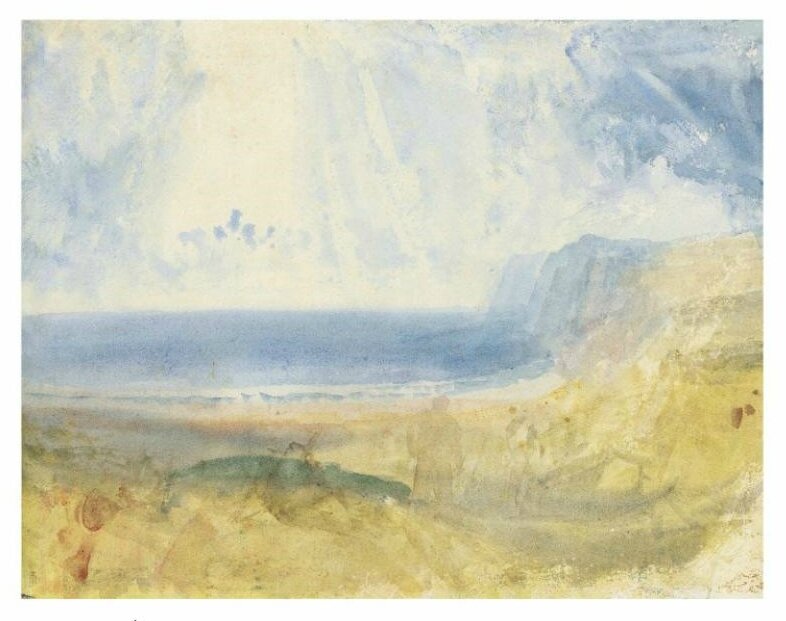Provenance: John Rutson (L. 1517).
Note: This previously unrecorded colour study was painted around 1822-4, when Turner was developing the last batches of watercolours for Picturesque Views on the Southern Coast of England. This long-running series, the first part of which had been published in 1813, was the project that fully established Turner among his contemporaries as the foremost painter of British topography. Known principally through the meticulous engravings realised from them, the forty detailed watercolours for the Southern Coast are now widely dispersed, and are increasingly rare outside museum collections (see The entrance to Fowey Harbour, Cornwall; Christie’s, New York, 27 January 2016, lot 88).
By the early 1820s, Turner and his publisher, William Bernard Cooke (1778-1855), were keen to complete the project, not least because they faced competition from William Daniell (1769-1837), who was drawing towards the end of his even more ambitious A Voyage round Great Britain. When re-examining the sketches made on his 1811 tour of the south-western counties Turner was looking particularly for subjects to evoke the rugged cliffs between Minehead, in Somerset, and Tintagel, to the west, in Cornwall. He had recorded this stretch of coast in two sketchbooks: Cornwall and Devon (TB CXXV a); and the somewhat larger Somerset and North Devon (TB CXXVI, Tate Britain).
The former sketchbook provided source material for three Southern Coast watercolours that share with this colour study a focus on rocky headlands and coves (Clovelly Bay, North Devon, National Gallery of Ireland, Dublin, fig. 1; W472; Combe Martin, Devonshire and Boscastle, Cornwall, both in the Ashmolean Museum, Oxford; W476 and W478). In each, the luminous, sandy colouring of the rocks is sharply contrasted with the deeper blue tones of churning clouds, which are themselves penetrated by bursts of brilliantly intense white sunlight. The palette tones and techniques deployed are sufficiently similar in all of these to speculate that they probably evolved during the same painting sessions, along with this study.
A further shared characteristic is their common fascination with the lives of those who forged a living from the raw materials of this coastal setting. Labourers involved in the quarrying and burning of lime are shown in two of the images, and it is likely that the shadowy, indistinct figure(s) and pack animals included here would have eventually been resolved in a way to highlight another aspect of this local activity.
A related colour sketch, in the Turner Bequest at Tate Britain, has been identified by Eric Shanes as a depiction of another local practice called ‘sand-landing’ (Turner’s Watercolour Explorations 1810-1842, Tate Gallery exhibition catalogue 1997, pp. 59-60, no. 41). Like the three finished watercolours, and this study, the Tate sheet is also around 24 cm. wide. This is significant because Turner was generally consistent in selecting sheets of approximately the same dimensions for a specific project. In the present colour study, however, the height of the sheet has not been trimmed the 3 or 4 centimetres along the bottom edge to the standard format.
As for the identity of the location depicted, this remains slightly uncertain. One possibility is that, like the Tate sketch, it may relate to the coast near Bude (see the sketch of cliffs, TB CXXV a 40 / D41318). But the higher viewpoint here seems to work against that conclusion. More plausible, therefore, is the possibility that the scene is a view from Lynton looking down over Lynmouth Bay (see the sketch in the larger sketchbook, TB CXXVI 16 / D08962). This part of the coast was to become a popular base for artists later in the 19th Century.
The early history of the watercolour is not known, but it bears the stamp of the collector John Rutson (1829-1906) of Nunnington Hall in Yorkshire, a former Director of the Royal Academy of Music, whose collection of three violins by Antonio Stradivari remain among the highlights of the Academy’s collection of instruments.
We are grateful to Ian Warrell for his help in preparing the present catalogue entry.
Christie's. Old Master & British Drawings & Watercolours, 5 July 2017, London, King Street

/https%3A%2F%2Fprofilepics.canalblog.com%2Fprofilepics%2F1%2F0%2F100183.jpg)
/https%3A%2F%2Fstorage.canalblog.com%2F03%2F02%2F119589%2F96711876_o.jpg)
/https%3A%2F%2Fstorage.canalblog.com%2F11%2F31%2F119589%2F94773502_o.jpg)
/https%3A%2F%2Fstorage.canalblog.com%2F20%2F83%2F119589%2F94772815_o.jpg)
/https%3A%2F%2Fstorage.canalblog.com%2F26%2F72%2F119589%2F75604929_o.jpg)
/https%3A%2F%2Fstorage.canalblog.com%2F59%2F60%2F119589%2F26458628_o.jpg)



/http%3A%2F%2Fstorage.canalblog.com%2F65%2F91%2F119589%2F128054923_o.jpeg)
/http%3A%2F%2Fstorage.canalblog.com%2F43%2F69%2F119589%2F122293629_o.jpg)
/http%3A%2F%2Fstorage.canalblog.com%2F45%2F75%2F119589%2F120660395_o.jpg)
/http%3A%2F%2Fstorage.canalblog.com%2F04%2F35%2F119589%2F110705752_o.jpg)